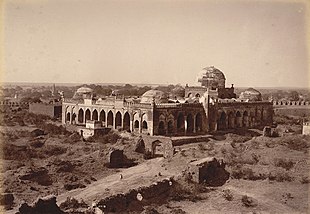Bahmani Sultanate
| Bahmani | |||||
| 1345/1347 - approx. 1490 | |||||
|
|||||
| Capital |
Gulbarga ("Ahsanabad") (1347–1425) Bidar ("Muhammadabad") (from 1425) |
||||
| Form of government | sultanate | ||||
| founding | 1345/1347 | ||||
| resolution | circa 1490 | ||||
| State religion: Islam Dynasty: |
|||||
| The Bahmani Sultanate around 1470 | |||||
| Great mosque in the fortress of Gulbarga | |||||
The Bahmani Sultanate was an Islamic state in central India and existed from 1345/1347 to around 1490.
history
Emergence
The sultanate came into being after the Delhi Sultan Muhammed Tughluk (r. 1325-1351) had given up his positions of power in central India and the Decan after a series of wrong decisions . He had all the tax officials in Gujarat executed, whereupon the uprising broke out among those in the Decan. Muhammed Tughluk defeated them quickly, but could not suppress all uprisings in his empire at the same time and so had to give up the decan.
Hasan Gangu Zafar Khan, a Turkish or Afghan officer, conquered Deogir or Daulatabad in 1345 and declared himself sultan under the title " Bahman-Shah ". He was confirmed in office by the Abbasid caliph in Cairo, al-Mu'tazid , and thus became the founder of the Bahmani Sultanate. The capital of the sultanate became Ahsanabad ( Gulbarga ) in 1347 .
Bahman Shah took over or defeated the remaining troops of the Delhi Sultan in the south and also took action against his Hindu neighbors. Under his successor Muhammad Shah (r. 1358-1375) these battles continued with greater severity, but without lasting success - after all, in 1366 he was able to conquer Warangal . Around 1400 the following neighbors were recorded: the Gajapatis in the northeast in Orissa and Gondwana , the Nayakas in Warangal in the east, the Rajas of Vijayanagar in the south, and the sultans of Malwa and Gujarat in the north and northwest.
Peak of power
Mohammed Shah II (r. 1378-1397) was considered "enlightened", founded orphan schools and invited the Persian poet Hafiz to come to him, but he had to turn back because of a storm. His successor Firuz Shah (r. 1397-1422) led the Bahmani Empire to the height of power and brought Vijayanagar two heavy defeats, so that Vijayanagar had to pay high war compensation and agree to a marriage (so-called "war for the goldsmith's daughter"). Firuz Shah was considered a scholar and is said to have owned a large harem, but fell out with his brother Ahmed and was murdered by him. Ahmed (r. 1422–1436) continued the war against Vijayanagar during his reign, also fought against the Sultanate of Malwa and in 1425 moved the capital to Muhammadabad ( Bidar ) , which is easier to defend .
The sultan's warfare and jurisdiction were generally cruel, the capitals and palaces were magnificent, and the Hindu peasants lived in greater poverty than in what was then Russia, as a traveler named Afanassi Nikitin described around 1470. Because of the numerical superiority of the Hindus and the constant wars, the sultanate was dependent on an immigration of adventurers from all countries of the Islamic world.
Disintegration through internal conflicts
Under Sultan Humayun (r. 1458–1461) there were bloody party battles between the Indian and immigrant Muslims (Arabs, Turks, Persians), in which the capable vizier Khalaf Hassan (Malik-ut-Tujjar) was murdered and in the course of which the originally mild sultan turned into a cruel ruler. After Humayun's murder, the Bahmani Sultanate seemed to break up, but was saved again by the reform minister Mahmud Gawan (1461–1481, executed).
Mahmud Gawan placed many tax districts, fortresses and some of the troops directly under the Crown. To this end, he controlled the allocation of posts right down to the lowest administrative levels in order to establish a balanced distribution of posts between the Indian and immigrant Muslims. He led the government while the young Sultan Muhammad III. (ruled 1463–1482) was dependent on wine. In the end, however, he was overthrown using a forged letter. Four years after Mahmud Gawan's execution, fighting flared up again between Indian and immigrant Muslims, so that the governors in the provinces successively declared their independence (1490).
The Bahmani Sultanate dissolved under the last Sultan Mahmud Shah IV (r. 1482-1518), who was only a pawn in the hands of his ministers and the king of Vijayanagar. Five independent successor sultanates emerged, the so-called Dekkan sultanates , including Bijapur (1490) and Golkonda (1512), which were only eliminated by the Mughal Mughal Aurangzeb .
List of Bahmani Sultans
- Aladdin Hassan Bahman Shah (1347-1358)
- Mohammed Shah I (1358-1375)
- Aladdin Mujahid Shah (1375-1378)
- Da'ud Shah (1378)
- Mohammed Shah II (1378-1397)
- Ghiyath ud-Din (1397)
- Shams ud-Din (1397)
- Taj ud-Din Firuz Shah (1397-1422)
- Ahmad Shah I. Wali (1422-1436)
- Aladdin Ahmad Shah II (1436-1458)
- Aladdin Humayun Zalim Shah (1458–1461)
- Nizam Shah (1461–1463)
- Mohammed Shah III. Lashkari (1463–1482)
- Mohammed Shah IV (Mahmud Shah) (1482-1518)
- Ahmad Shah III. (1518–1521)
- Aladdin (1521-1522)
- Wali-Allah Shah (1522-1525)
- Kalim-Allah Shah (1525-1527)
literature
- Hermann Kulke , Dietmar Rothermund : History of India. 2nd, improved and updated edition. CH Beck, Munich 1998, ISBN 3-406-43338-3 .
- Hermann Goetz : History of India (= Kohlhammer-Urban-Taschenbücher. 59, ZDB -ID 995319-x ). Kohlhammer, Stuttgart 1962.

